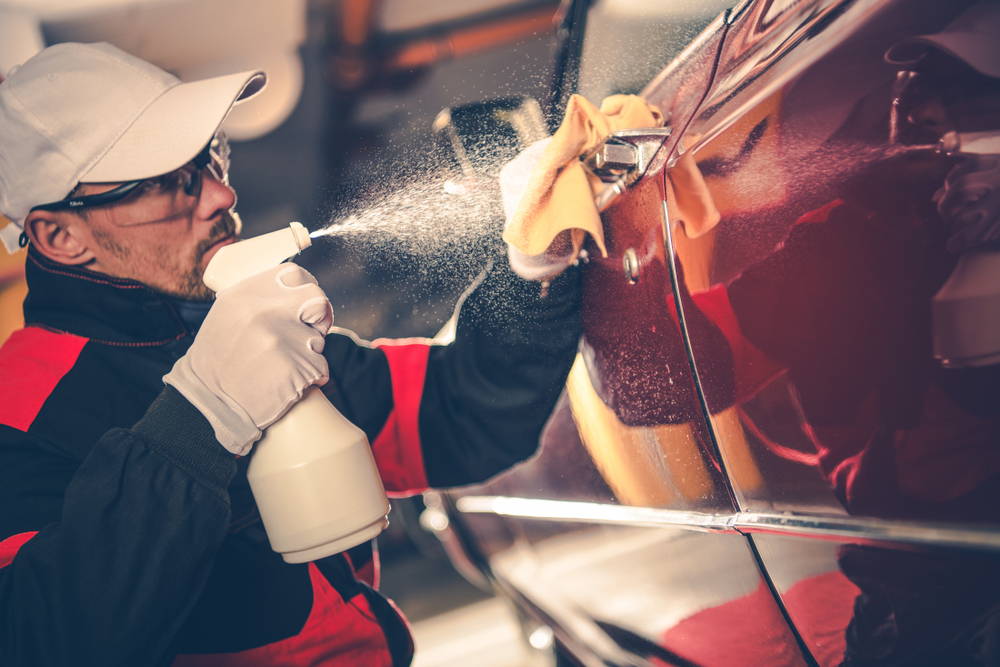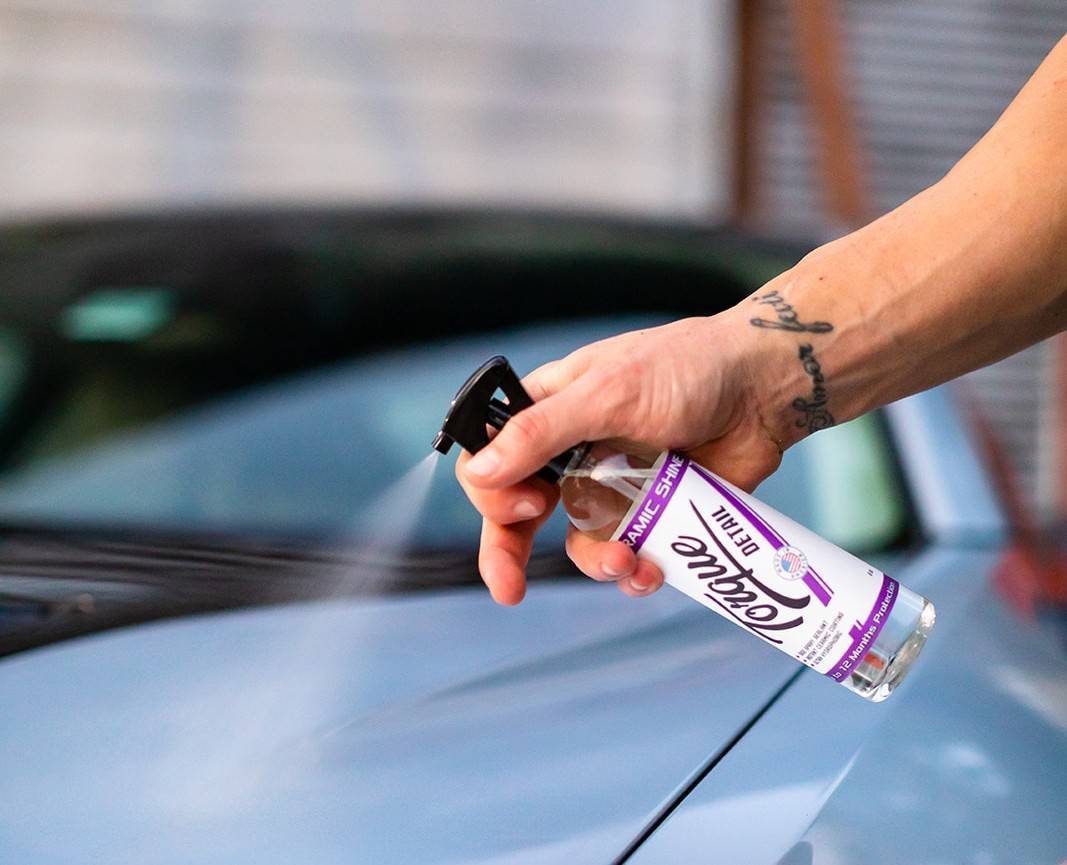Whether you have a brand new whip or a busted clunker a protective sealant coat can instantly spruce up your ride.
Now, you’re ready to take on the task of washing and detailing your car yourself, but where do you start? What detailing products do you need? How long does it take? Is it worth it? Should you just hire a professional?
All these questions can overwhelm a detailing novice, but they don’t have to.
Our car detailing guide takes you through the two main types of paint protection commercially available: Carnauba wax and ceramic coating. In the battle of the paint protection titans, who stands apart as the best overall?
"My car is slick as glass!! I put the Ceramic Spray on my Corvette Stingray and it is very slick and shiny. I should have purchased it sooner. It is a great product. It made my wheels look new. Keeps off dirt and dust." - Charlie F.
What is Carnauba Wax?
Pronounced “kar-newb-uh”, this refined wax originates from a palm plant (Copernicia prunifera) native to northeastern Brazil.
In nature, the wax is used to provide the palm with a protective layer against the sun’s uv rays.
Pictured above, a Carnauba tree. Its wax is able to protect its leaves from UV rays in the same way that it protects your car.
When refined, carnauba wax produces a high shine, perfect for automotive wax, shoe polish, dental floss, and many other industrial uses.
Originally in yellow and brown flake form, carnauba waxes are blended with solvents for improved solubility and oils for lubrication, as well as scents and coloring agents.
It’s also worth noting that Carnauba wax is not the only wax. Montan and paraffin waxes are also commonly used as automotive coatings. Although paraffin is mostly just an ingredient in detailing products that you never hear about. There’s even beeswax.
Carnauba gives the classic glass-like shine car enthusiasts love, beeswax is more of a warm color and Montan gives a wet and shiny look.
What is Ceramic Coating
Ceramic coating technology has taken the detailing game by storm. As a relatively newer alternative to the traditional automotive wax, ceramic coating provides a higher level of paint protection.
Ceramic-based sealants are liquid-polymers derived from quartz, silica, and silicone-dioxide.
Ceramic coating owes the bulk of its efficacy to nanoparticles within the paint sealant. Nanoparticles in the sealant range in size from 80 to 100 nanometers. For perspective, there are 10 million nanometers in a millimeter.
Nanoparticles work by adhering to the surface of your car and sealing all of its pores. The result? Your car’s paint will be hydrophobic, as in, water-repellant. Not only that, but it’ll also be able to better withstand harsh chemicals, scratches, UV damage, debris, and the heat.
As a side note, you now know why a ceramic coating may also be referred to as a nano coating!
How to Apply Wax
Wax is an affordable and dependable coating option to protect your car’s paint, that is, if you properly apply the wax. Don’t make it all for naught and follow our application recommendations.
Regardless of the type of consistency of your wax, always use an applicator pad to apply the sealant. Foam applicators come in various shapes and sizes. Make sure to choose one that works well with your hand size.
Let’s talk about temperatures. Ideally, you’ll want to apply your sealant in a cool and shaded area. Most car owners apply their wax in the summer when the weather is nice, but start considering a winter coating, instead or additionally.
If you’re taking advantage of the long summer days, wait to start waxing in the evening to avoid most of the blistering sun’s wrath and allow the wax to dry overnight. We recommend waxing in temperatures between 60 and 80º F.
Now, let’s get into the nitty-gritty of applying the wax. For optimal results, work on one car panel at a time.
- Apply a thin coat of wax in a circular motion with the applicator pad.
- Allow the wax to “haze” for about five to 10 minutes.
- Buff the surface with a soft microfiber towel or a variable-speed buffer.
- Repeat the process on each panel.
How to Apply Ceramic Coating
How you apply ceramic coating depends on the type you’re using. Are you doing the work yourself or hiring someone else?
DIY Ceramic Coating Spray
Ceramic coating spray application can be performed by your everyday car owner. Begin by washing your car and rinsing the surface to remove any dirt, debris, and grime that could reduce protection.
Here’s where it gets tricky. Using a clay bar and a lubrication fluid, you’ll want to get rid of any hard-to-remove grime, sap, or overspray to leave behind a smooth surface. Creating a smooth surface helps the ceramic coating spray adhere evenly to the paint.
Firmly slide the clay bar across the surface of your car after applying the liquid solution to help break up the grittiness. A grainy surface produces an audible noise as you run the palm of your hand across it.
Now that your car’s surface is smooth, you can proceed with the paint correction process if that is something you are concerned about. Removing everything from spider webbing to fine scratches to water spots helps with the rest of the application process.
Reverse: Scratch Remover and Swirl Repair
The newest car detailing product that easily removes scratches and swirls by hand.
Ideally, paint correction should be performed by a professional, but you can get away with a DIY paint correction using an electric polisher.
Once the paint correction is complete, you can wipe down your car surface with an isopropyl alcohol solution as a last-ditch effort to remove any oils, chemicals, waxes, and other nanoparticles left.
Now, it’s time to apply that ceramic coating.
DIY ceramic coating products typically come in spray or a sort of paste form. In this article, we’ll show you how to use our very own US-made Ceramic Spray.
Shake the bottle and spray a small amount of the ceramic coating product on the surface. We mean it. Less is really more. Use a clean microfiber cloth to spread out the coating and work it into the surface.
Get out a second clean microfiber towel and begin to really buff the product into the surface until you reach your ideal shine.
Do your car one small section at a time.
After you’re all done, let the car sit for 6-12 hours in a cool and dry area. Ideally, you’ll want the car to be in a covered area, such as a garage or carport, to avoid falling leaves.
Traditional Ceramic Coatings
Traditional ceramic coatings are applied in a similar fashion as DIY Ceramic Sprays, but the professional ceramic coat can take up to 30 days to completely harden and provide the ultimate protection.
The process of applying the traditional ceramic coating can take up to five days to complete, which includes time for prep and paint corrections.
Traditional ceramic coatings start off with a clay bar treatment, albeit, professional detailers use deionized water and degreaser to prevent scratching the car.
Next comes the drying process using compressed air to reduce surface contamination. Paint correction comes afterward followed by a ceramic coat application.
The ceramic coat application is much more extensive than a DIY application. Professional detailers begin with a primer polish in a contained area away from the dirt and water spray around.
The car is wiped down with alcohol and water and the first layer of ceramic coating is applied, as well as additional layers for an ultra-protective shine. Some detailers will use a heat lamp to stimulate the solution’s active ingredients.
How Long Does Each Coating Last?
Car wax and ceramic coating’s longevity depends on unique factors such as how often you drive, where you park your car, and other variables that affect your car’s paint (and clear coat!).
Here at Torque Detail, we recommend applying an even coat of wax monthly for cars that are driven a normal amount and are parked under shade or inside a garage most of the time.
If, however, you’re out on the road a lot under unforgiving conditions and you’re parked out roasting under the sun all day, then you’ll want to increase the frequency of adding wax to your car.
When it comes to a typical ceramic coating, you’ll probably need to re-apply a coat every three to four months or more. Our Ceramic Spray formula is rated for up to 12 months. That’s a considerable difference in protection time between ceramic coating and traditional wax.
Which Offers The Best Paint Protection?
Ceramic coating, by far, offers the best paint protection for your car, truck, or SUV. A solid application of this high-grade liquid-polymer can take on almost anything you throw at it, literally.
Whether it’s the spilled coffee from leaving your thermos on the roof of your car while driving away or a torrential storm, ceramic coating cuts deep into the pores of the paint to create a slick surface that can make it easier for you to slide across the hood of your car à la them Duke boys.
Ceramic coating protects your car paint from the damaging effects of UV light, the bugs and road debris you pick up on the road, and can even withstand a high-pressure car wash.
Can You Use Them Both in Tandem?
If wax and ceramic coatings both work to protect your car’s paint, then both of them used together should enhance their protective effects, right? In theory, yes, but there are a few reasons why it’s more trouble than it’s worth.
Let’s assume that you apply the ceramic coating first and let it cure and apply the wax afterward. The ceramic coating will do such a good job of protecting the car’s paint, that applying the wax on top will be nearly impossible.
If you do decide to add that additional wax coating, it’s likely to degrade faster on top of the ceramic sealant rendering your hard work useless. Stick to just a ceramic coating if you want to apply a single protective layer.
Which Costs More and Why?
Cost can be a big issue for budget-conscious consumers who want the best bang for their buck. If money is no object, then you’re probably springing for the ceramic coating applied by an expert detailer.
Cost depends largely on whether you have someone do the work for you or if you’re willing to learn what you can on your own. Factor in the amount of prep work including paint repairs needed to get your car ready for a ceramic coat.
When we talk about cost, we factor in the time and labor involved. How long is it going to take you to learn the ropes and buff out your sealant? Is it worth your time? Could you save more time and money in the long run by having it professionally completed?
Let’s start by breaking down the cost of the products needed for your ceramic coating and car waxes.
Expect to pay about $20-$40 for a 16oz bottle of wax. Ceramic products tend to be a bit more expensive.
How liberally you apply the product to get the result you desire will determine what your yearly DIY detailing costs will be. I know people who are able to bang out 20 cars with a 16oz bottle. I also know people who can only do 4 with the same amount. You can expect to purchase anywhere from 1-3 bottles per year.
Grab yourself a pack of microfiber towels for about $10 or a high-speed polisher for about $100. Up to you!
After that, you’ll want some car shampoo, a clay bar, and a clean wash bucket if you don’t already have one. Optionally, purchase some clay bar lube as well. If you don’t want this extra purchase, simply mix up a fresh bucket of car shampoo with water and that will get the job done for you.
Now, what about getting your car professionally detailed with ceramic coating? A professional detail can take up to five days including prep and curing time. Cost depends on where you get your work done and which detailing package you choose.
A basic package can run you between $600 and $900 and includes a wash, removal of previous wax, and a polish.
A mid-grade package can cost between $900 and $1,400 and typically includes multiple layers of protection.
The highest package can end up costing between $1,500 and $2,500 for a high-grade coating and an ironclad warranty.
These prices don’t even take into consideration the upkeep required after a professional detailing service which can include the price of wax and professional car washing services.
When You Should Use Each Type - Ceramic vs. Wax
Use a ceramic coat if…
- Your car has a new paint job
- You drive regularly and maintain your car well
- You wash your car regularly
- Your vehicle can benefit from a quick and easy wash
Use a wax if…
- You drive daily under harsh conditions
- Your car gets easily dirty and you don’t have time to wash it immediately
- Your car is vulnerable to scratches or dents
- You have a tighter budget
The Pros and Cons of Ceramic Coating vs. Wax
The Pros of Wax
- Naturally-sourced: The eco-friendly choice for the conscious consumer, carnauba wax offers value over completely synthetic alternatives.
- User-friendly: Car waxes are affordable, widely accessible, and easy to use, especially for first-time detailers. The short time it needs to haze after application makes it a great entry-level sealant.
- High Shine: Car waxes, especially carnauba wax, covers all your paint’s inconsistencies giving it a glossy and polished look.
- Accessible: Car wax is able to meet the demands of the common car owner and car enthusiasts and collectors. You don’t need to hire professional help to use this stuff, either.
- Affordable: Car wax is affordably-priced for car owners of any budget, albeit, you tend to get what you pay for.
- Hydrophobic Properties: Carnauba wax produces a slick surface that causes water to slide right off.
- Meditative: The process of waxing your car can be therapeutic in the right setting.
The Cons of Wax
- Low-Protection: Car wax is only applied as a thin layer of protection offering the least amount of durability against scratches or road grime.
- Short Protection Span: Even the highest quality waxes can last up to six weeks, at most, including a brief period where the performance of the wax decreases. A short protective window also means more frequent re-application.
The Pros of Ceramic Coating
- Durable: Ceramic car coatings harness the same nanotechnology used to treat space shuttles due to their insulating and anti-corrosive characteristics.
- Hydrophobic: Kiss water spots goodbye. Ceramic coating makes washing your car a cinch and gives your car a glossy sheen.
- UV Protection: Ultraviolet-light has two main effects on your car’s paint: it breaks down the chemical bonds in your paint causing it to fade and increases the rate of oxidation causing a dull and chalky surface.
- Protection from the Environment: Ceramic coating can take on mud, bugs, bird droppings, and acid rain.
- High Gloss: Check out your reflection in your newly ceramic-coated car. Expect a glossy finish that’ll give your car that fresh-off-the-lot look.
The Cons of Ceramic Coating
- Time-Consuming: Not only do you have to apply the coating carefully and wait for it to cure, but you also have to keep your car clean more often to prevent the dirt from sticking to your coating.
- Difficult to Apply: Ceramic coating is best applied by a professional, but adept car owners can do a bang-up job without one, once they beat the learning curve.
- Expensive: The price of products, labor, and man-hours put into applying ceramic coating can be off-putting for those short on cash.
Ceramic Spray - Spray On Ceramic Coating
Get showroom shine with diamond-like protection in just minutes! Car maintenance has never been easier.
Summary
Ultimately, the best choice of wax or ceramic coating comes down to personal preference. Do you prefer the old-school method of applying wax? Do you value the protective power of a ceramic coat? There are no wrong answers here. Why not try both and decide for yourself.
Besides your choice of car sealant, one of the most important parts about protecting the paint quality of your car is how you take care of your vehicle. By cleaning and maintaining your car regularly, you can extend the life of the coating used.
Check out our line of easy-to-use detailing products to bring your car back to its glory days.







